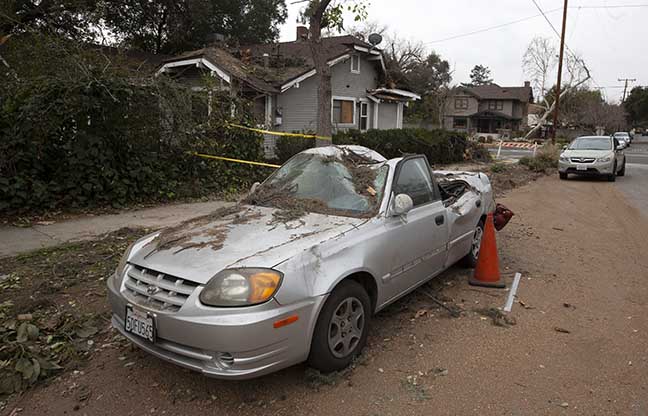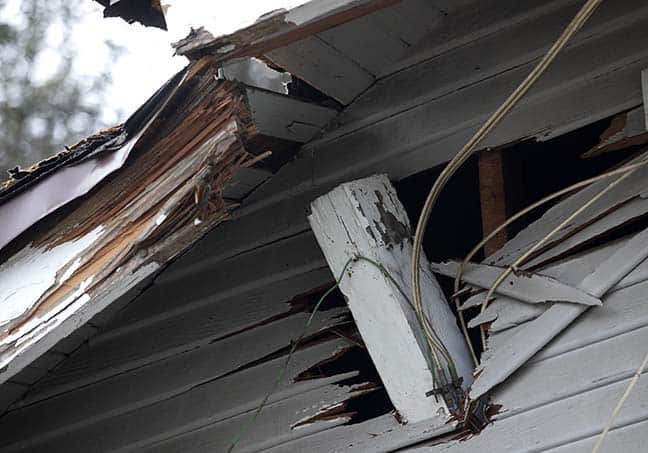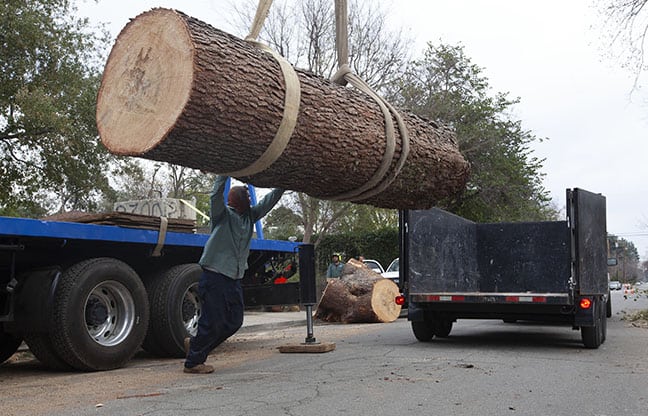Digging out from storm may take weeks

The path of destruction caused by one fallen tree can be seen in this smashed vehicle on Seventh Street and the damaged home on Indian Hill Boulevard in Claremont. Two weeks after the devastating storm, there was much work left before the city can fully recover. This home is one of 16 in Claremont that were red tagged, meaning its uninhabitable until repaired. COURIER photo/Steven Felschundneff
by Steven Felschundneff | steven@claremont-courier.com
The winds have long died down and have been replaced by a symphony of chainsaws and leaf blowers. Our streets are once again passable, the power has been restored and only a few of us were forced out of our homes. But the clean up has really just begun.
Now almost two weeks after the “once in a generation” windstorm swept through Claremont, people are doing what they can to return to pre-storm routines. For most, that means disposing of the mounds of tree-related debris deposited in every conceivable square inch of the yard. To assist in the self help effort, the city made two green waste pickups again this week, and the roll-off dumpsters stationed at city parks will remain for an undetermined period of time.
In the first few days immediately after the storm, city crews focused on mitigating any situation that posed a threat to public safety, and then went about clearing the right-of-way. Now that those efforts are largely complete the city will begin general tree debris removal on a “grid” system according to Director of Community Services Jeremy Swan.
The official clean up effort first focused on the area south of Foothill and east of Indian Hill boulevards, which the city has labeled grid four, and that work is mostly finished. On Tuesday the teams were dispatched to grid two, north of Foothill from Indian Hill to the western city limit, which is expected to be completed Friday. Next week, they will focus on the area north of Foothill and east of Indian Hill. Swan said it would likely take a couple of weeks before all debris is removed from Claremont’s streets and medians.
“City crews will clear every city street of debris in the city right-of-way (street, curb, sidewalk) one time. Once they are through an area, they will not return to clear debris. We’d like to thank those residents that have assisted the city with clearing debris adjacent to their properties. As a reminder, special green waste collection will continue through the end of the week and roll offs remain in parks for extra green waste collection,” city officials said in a statement.
Even after the downed trees are gone, the storm’s legacy will likely remain for months with numerous sidewalks that were displaced as the trees fell. That project will involve removing the root ball, demolishing existing concrete and pouring new cement.
The tree debris collected by the city will, for the most part, be chipped to make mulch, however, there are no current plans for a public mulch distribution event. This is mainly because the independent tree cutting crews hired by the city have already removed the bulk of the mulch to other locations.
A number of local artists and artisans have inquired about obtaining wood from the heritage oaks that were felled by the storm, in particular the one that for years was in front of Garner House in Memorial Park. Distribution of wood from felled oaks will be handled by the public art committee.
Swan could not provide an estimate of the total cost for storm recovery, however, his department in conjunction with other city agencies was preparing a preliminary disaster assessment which should be ready by the end of next week. That document would be a key part of the application for reimbursement from the state of California.
On Monday, a team of about a dozen workers using hand tools and another operating a large crane were removing the massive stump of the fallen pine that blocked Eighth Street. By midmorning the tree’s trunk had already been divided into several pieces, but the root ball proved to be a greater challenge.
A small crowd of onlookers gathered on the south side of Eighth, including Lenore and Jim Brashler whose home was partially damaged by the fallen tree. As the men worked on the tree, another crew was already fixing the Brashler’s roof including replacing some rafters.
Claremont resident Rodney Hutchinson backed his truck and trailer up to the spot where several enormous pieces of the pine were placed. On cue the crane pivoted to load one section of the pine’s trunk onto Hutchinson’s trailer.
He plans to take the roughly 5,300 pound section back to his home but isn’t sure how he will repurpose it. “I just like trees,” he said.
Hutchinson has kept busy since the storm hit, including going to work with his chainsaw and truck to clear trees that blocked Towne Avenue for 18 to 19 hours.
“It’s a disaster,” he said. “You have to pitch in, you can’t just sit back and watch the world turn.”
On Wednesday Claremont Public Information Officer Bevin Handel said in the three days following the storm police dispatch fielded 546 calls and community services another 500-plus calls. The city has received 168 online damage reports.
Handel checked with Chris Morgan, the city’s building official, and Claremont has 16 red-tagged structures, those that are considered unsafe to enter, and 12 that are yellow tagged, which allow limited entry. The building inspector will be reevaluating these structures in the coming weeks if repairs have been made.
The city is still reporting no injuries from the storm, however, the COURIER interviewed Jennifer Sasaki who was sleeping in her Harrison Avenue home when a large eucalyptus crushed her bedroom, raining debris on the bed. Sasaki escaped with minor cuts and bruises and one moderate cut to her head that required stitches. She was taken to the hospital by her husband.
Handel said the city used dispatch call logs to determine the “no injury” report, however, Sasaki did call 9-1-1 and first responders came to her aid.













0 Comments